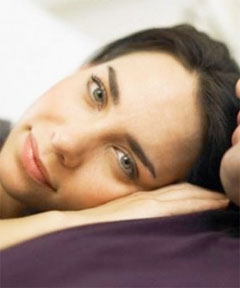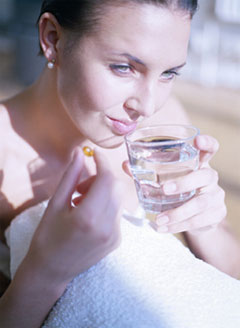|
|
Low Libido in Women: Demystified

Low Libido in Women occurs when a woman is not able to fully, healthily, and
pleasurably experience some or all of the various physical stages the body
normally experiences during sexual activity. These stages can be broadly thought
of as the desire phase, the arousal phase, and the orgasm phase. Sexual
dysfunction also includes painful intercourse.
In women low Libidon takes many forms and has numerous causes. It is important
to address all the aspects of a woman's sexuality - whether physical,
psychological, physiological (mechanical), or interpersonal - in order to
resolve the problems.
Low Libido in Women is actually quite common. It has been estimated that about
40% of women are affected by sexual dysfunction to some degree, and
approximately 1 in 4 women are unable to achieve orgasm.
Causes of Low Libido in Women
Low Libido in Women may be related to physical factors, psychological factors,
or a mixture of both. It can also be a matter of problems with technique: Some
women never fully experience sexual arousal and orgasm because they or their
partners lack sexual knowledge. They may not understand how female sex organs
respond or are stimulated, or don't use appropriate arousal techniques.
At the same time, Low Libido in Women has a strong interpersonal component. A
person's view of their own sexuality is largely influenced by culture, society,
and personal experience. It may be intimately connected to their own or
society's ideas about the appropriate or inappropriate expression of sexual
behaviour. These feelings may cause anxiety because of a personal or cultural
association of sexual experience and pleasure with immorality and bad behaviour.
Anxiety is then expressed physically by the body in a way that prevents normal
sexual function. Anxiety can do this, for example, by stopping or slowing the
state of sexual excitement that allows for the lubrication or moistening of the
female genitalia - an important step towards fulfilling forms of sexual
activity.
Personal character, disposition, and life experience play a role in sexual
dysfunction. Fear of intimacy can be a factor in arousal problems. Experiences
of abuse, either in childhood or in past or current relationships, can establish
a cycle of associating sex with psychological or physical pain. Attempting
sexual activity in these circumstances causes more psychological or physical
pain. For example, if anxiety prevents lubrication, sexual intercourse can be
painful.
Conflict, tension, and incompatibility with a sexual partner can cause sexual
dysfunction. Depression may be a cause, and stress a contributing factor.
Medications, including oral contraceptives, antihypertensives, antidepressants,
and tranquilizers are very common causes of sexual dysfunction. Also, the use of
oral contraceptives can decrease a woman's interest in sex. If you're taking any
of these medications, talk to your doctor about its possible contribution to
sexual problems.
Physical causes include disorders of the genitalia and the urinary system, such
as endometriosis, cystitis, vaginal dryness, or vaginitis. Other conditions such
as hypothyroidism, diabetes, multiple sclerosis, or muscular dystrophy can have
an impact on sexual desire and ability. Surgical removal of the uterus or of a
breast may contribute psychologically to sexual dysfunction if a woman feels her
self-image has been damaged.
Certain prescription and over-the-counter medications as well as the use of
illegal drugs or abuse of alcohol may contribute to sexual dysfunction.
Cigarette smoking may have a negative effect on sexual arousal in women.
Although women can remain sexually active and experience orgasms throughout
their lives, sexual activity often decreases after age 60. While part of this
may be due to a lack of partners, changes such as dryness of the vagina caused
by lack of estrogen after menopause may make intercourse painful and reduce
desire. After menopause, about 15% of women feel a strong decrease in sexual
desire.
Symptoms and Complications of Low Libido in Women
Women who do not enjoy satisfying sexual experiences with their partners often
report the following:
-
 lack of sexual desire (low libido) lack of sexual desire (low libido)
-
inability to attain an orgasm
-
pain or other distress during penile penetration
-
an inability to fantasize about sexual situations
-
indifference to, or repulsion by, having sex
-
feelings of fear or anger towards their partners
Most often, any of these responses have psychological complications. Whether
the symptoms are due to physical factors, such as menopause, or have their
origins in more *deep-seated psychological triggers, many women are likely to
feel inadequate or dysfunctional. They blame themselves for not being sexually
responsive, have trouble explaining *to their partners about how they feel, and
experience low self-esteem as a result.
Diagnosing Low Libido in Women
Establishing the cause of sexual dysfunction is half the battle. The stage of
sexual activity at which a woman is having problems may offer some clues. Other
evidence may be found through physical and psychological testing. Your family
doctor can refer you to specialists who can help pinpoint what's causing the
problem.
In sexual desire disorder, a woman experiences a decreased interest in having
sex. If the lack of interest is new and extends to all partners and situations,
the doctor will likely consider causes such as medications, medical conditions
such as depression, hormonal changes, or imbalances in certain neurotransmitters
(the brain's chemical messengers). On the other hand, sexual desire disorder may
be caused by interpersonal factors if it's confined to one partner or one
situation.
Sexual arousal disorder refers to a woman's inability to become lubricated,
aroused, or sexually excited, even after being sexually stimulated.
Orgasmic disorder means that a woman may enjoy sexual activity but has
difficulty reaching orgasm or takes a very long time to reach orgasm. Physical
causes are rare, except in cases of nerve damage in the spine. Psychological
factors may range from never having learned how to have an orgasm, to
unrealistic expectations from a partner, to feelings of guilt at experiencing
pleasure. Orgasmic disorder is diagnosed only when a woman has no difficulty
with arousal, only with climax.
Treating and Preventing Low Libido in Women
The first step in managing female sexual dysfunction is to see a health care
provider for assessment and appropriate treatment.
Physical disorders should be treated. For sexual dysfunction associated with
aging and dryness of the vagina, vaginal moisturizers or estrogen treatment
(such as a vaginal cream, vaginal ring, or low-dose tablet taken by mouth) can
be effective.
When psychological factors are foremost, counselling from a psychiatrist,
psychologist, or sex therapist may help to remove or reduce the causes.
Psychotherapy may be more useful if there has been some trauma in a woman's
background, or problems that stem from stress or relationships. Therapy that
includes a sexual partner is more helpful in increasing the chance of learning
to experience orgasm.
To both treat and prevent sexual dysfunction, women should understand how their
sex organs work and how they can respond. The vagina is like a muscle, and with
inactivity, it becomes harder to use. Activities like masturbation and Kegel
exercises can increase blood flow to the vaginal area, making sex more
comfortable. Kegel exercises can make pelvic floor muscles stronger and help
women reach orgasm more easily. This is a technique that women of every age can
use to enhance sexual pleasure.
To do Kegel exercises, tighten your pelvic floor muscles (these are the same
muscles you use to stop the flow of urine when you're going to the bathroom) for
3 seconds, relax for 3 seconds, and repeat 10 times. Gradually increase the time
until you are tightening the muscles for 10 seconds and relaxing for 10 seconds.
Researches for Low Libido in Women
 In late 2004, FDA approval of Intrinsa, a testosterone patch for low female sex
drive, seemed imminent. News reports heralded Intrinsa as a "Viagra for her,"
suggesting that it would revolutionize sexual health for women.Except an FDA
advisory panel saw things differently. Finding numerous problems with the
evidence for the drug's effectiveness and safety, experts on the panel voted
against approving it. In late 2004, FDA approval of Intrinsa, a testosterone patch for low female sex
drive, seemed imminent. News reports heralded Intrinsa as a "Viagra for her,"
suggesting that it would revolutionize sexual health for women.Except an FDA
advisory panel saw things differently. Finding numerous problems with the
evidence for the drug's effectiveness and safety, experts on the panel voted
against approving it.
Now the frontrunner in the race to market the first prescription drug for low
female sex drive is Boehringher-Ingelheim Pharmaceuticals. It has a drug called
flibanserin in phase III clinical trials, the final phase of drug testing
required for FDA approval. It is a kind of antidepressant, but it hasn't been
approved previously for any use. Boehringher-Ingelheim is saying little publicly
about the drug.
Another drug, called bremelanotide, is in development for low female sex drive
and male erectile dysfunction at the same time. Both potential uses are being
tested in phase II clinical trials, which are early studies to assess how well a
drug works and how safe it is.
Bremelanotide is a new chemical created in the laboratory. It's given in the
form of a nasal spray, and it acts on the central nervous system.
"It's actually working in a region of the brain called the hypothalamus, which
is known to be involved in sexual arousal in both men and women," says Carl
Spana, PhD, CEO of Palatin Technologies, the company researching bremelanotide.
Dated 25 October 2013
|
|
|
|
|









